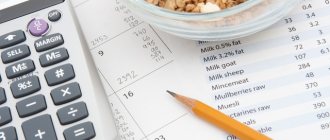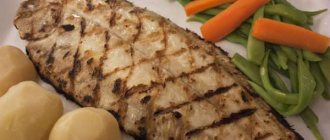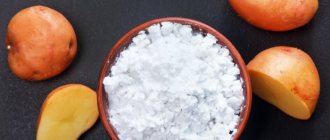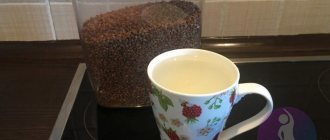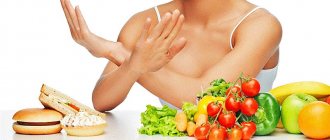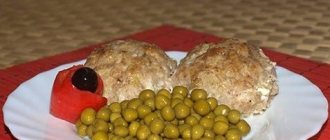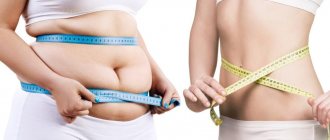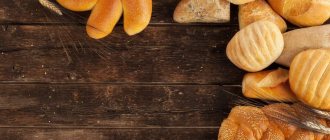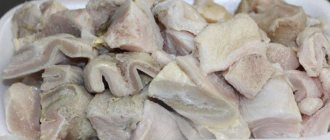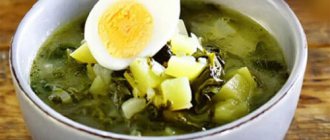Calorie table for fish and seafood
| Product | Quantity | Energy value (kcal) | Proteins (g) | Fat (g) | Carbohydrates (g) |
| Sturgeon balyk | 100 g | 194 | 20,4 | 12,5 | 0,0 |
| Beluga blanched | 100 g | 234 | 23,3 | 15,6 | 0,0 |
| Beluga fresh | 100 g | 147 | 21,0 | 0,7 | 0,0 |
| Dried roach | 100 g | 235 | 46,4 | 5,5 | 0,0 |
| Cold smoked roach | 100 g | 181 | 31,1 | 6,3 | 0,0 |
| Pink salmon in tomato sauce | 100 g | 132 | 14,5 | 5,1 | 6,9 |
| Boiled pink salmon | 100 g | 168 | 22,9 | 7,8 | 0,0 |
| Fresh pink salmon | 100 g | 147 | 21,0 | 7,0 | 0,0 |
| Salted pink salmon | 100 g | 169 | 22,1 | 9,0 | 0,0 |
| Pink salmon, canned | 100 g | 136 | 20,9 | 5,8 | 0,0 |
| Zrazy from pike perch | 100 g | 164 | 12,1 | 7,4 | 12,1 |
| Zrazy from hake | 100 g | 140 | 13,1 | 5,6 | 9,3 |
| Fried catfish | 100 g | 209 | 22,2 | 11,5 | 4,1 |
| Boiled catfish | 100 g | 114 | 15,5 | 5,8 | 0,0 |
| Catfish baked in sour cream sauce | 100 g | 137 | 7,4 | 8,8 | 6,8 |
| Beluga caviar granular | 100 g | 237 | 27,2 | 14,2 | 0,0 |
| Granular pink salmon caviar | 100 g | 230 | 31,2 | 11,7 | 0,0 |
| Chum salmon caviar granular | 100 g | 251 | 31,6 | 13,8 | 0,0 |
| Pollock caviar, punched | 100 g | 131 | 28,4 | 1,9 | 0,0 |
| Sturgeon caviar granular | 100 g | 203 | 28,0 | 9,7 | 0,0 |
| Pressed sturgeon caviar | 100 g | 236 | 36,0 | 10,2 | 0,0 |
| Sevruga caviar grainy | 100 g | 221 | 28,4 | 11,9 | 0,0 |
| Cod roe | 100 g | 115 | 24,0 | 0,2 | 0,0 |
| Boiled squid | 100 g | 110 | 18,0 | 4,2 | 0,0 |
| Fresh squid | 100 g | 74 | 18,0 | 0,3 | 0,0 |
| Flounder in oil | 100 g | 249 | 14,4 | 21,3 | 0,0 |
| Flounder in tomato sauce | 100 g | 125 | 12,6 | 5,4 | 6,3 |
| Hot smoked flounder | 100 g | 192 | 22,0 | 11,6 | 0,0 |
| Boiled flounder | 100 g | 103 | 18,3 | 3,3 | 0,0 |
| Fresh flounder | 100 g | 83 | 16,5 | 1,8 | 0,0 |
| Boiled crucian carp | 100 g | 102 | 20,7 | 2,1 | 0,0 |
| Fresh crucian carp | 100 g | 87 | 17,7 | 1,8 | 0,0 |
| Carp in tomato sauce | 100 g | 145 | 12,4 | 8,7 | 4,1 |
| Boiled carp | 100 g | 102 | 16,0 | 3,7 | 2,0 |
| Fresh carp | 100 g | 110 | 18,0 | 4,2 | 0,0 |
| Fresh chum salmon | 100 g | 138 | 22,0 | 5,6 | 0,0 |
| Salted chum salmon | 100 g | 184 | 24,3 | 9,6 | 0,0 |
| Chum salmon, canned | 100 g | 129 | 21,5 | 4,8 | 0,0 |
| Fresh mullet | 100 g | 124 | 21,0 | 0,4 | 0,0 |
| Hot smoked sprat | 100 g | 162 | 21,3 | 8,5 | 0,0 |
| Spicy salted sprat | 100 g | 154 | 14,8 | 10,5 | 0,0 |
| Salted sprat | 100 g | 137 | 17,1 | 7,6 | 0,0 |
| Whale meat | 100 g | 119 | 22,5 | 3,2 | 0,0 |
| Canned crabs | 100 g | 85 | 18,7 | 1,1 | 0,1 |
| Boiled crabs | 100 g | 96 | 16,0 | 3,6 | 0,0 |
| Canned shrimp | 100 g | 81 | 17,8 | 1,1 | 0,0 |
| Boiled shrimp | 100 g | 95 | 18,9 | 2,2 | 0,0 |
| Fresh shrimp | 100 g | 97 | 22,0 | 1,0 | 0,0 |
| Bream in tomato sauce | 100 g | 138 | 15,3 | 7,4 | 2,6 |
| Dried bream | 100 g | 221 | 42,0 | 5,9 | 0,0 |
| Hot smoked bream | 100 g | 172 | 32,8 | 4,5 | 0,0 |
| Boiled bream | 100 g | 126 | 20,9 | 4,7 | 0,0 |
| Fresh bream | 100 g | 105 | 17,1 | 4,1 | 0,0 |
| Cold smoked bream | 100 g | 160 | 29,7 | 4,6 | 0,0 |
| Smoked salmon | 100 g | 162 | 21,5 | 8,4 | 0,0 |
| Salmon from the grill | 100 g | 283 | 20,7 | 22,3 | 0,6 |
| Fresh salmon | 100 g | 201 | 19,9 | 13,6 | 0,0 |
| Salted salmon | 100 g | 269 | 21,0 | 20,5 | 0,0 |
| Salmon sauté | 100 g | 379 | 21,1 | 31,4 | 4,1 |
| Boiled mackerel | 100 g | 124 | 22,8 | 3,6 | 0,0 |
| Boiled mussels | 100 g | 50 | 9,1 | 1,5 | 0,0 |
| Boiled pollock | 100 g | 79 | 17,6 | 1,0 | 0,0 |
| Fresh pollock | 100 g | 73 | 16,6 | 0,6 | 0,0 |
| Fresh capelin | 100 g | 157 | 13,4 | 11,5 | 0,0 |
| Sea kale | 100 g | 5 | 0,9 | 0,2 | 0,0 |
| Boiled burbot | 100 g | 92 | 21,4 | 0,7 | 0,0 |
| Fresh burbot | 100 g | 80 | 18,8 | 0,6 | 0,0 |
| Hot smoked sea bass | 100 g | 175 | 23,5 | 9,0 | 0,0 |
| Boiled sea bass | 100 g | 112 | 19,9 | 3,6 | 0,0 |
| Fresh sea bass | 100 g | 117 | 17,6 | 5,2 | 0,0 |
| Stewed sea bass | 100 g | 120 | 10,9 | 6,6 | 4,2 |
| Fried river perch | 100 g | 180 | 20,6 | 9,1 | 4,0 |
| Baked river perch | 100 g | 103 | 6,8 | 4,7 | 8,4 |
| Poached river perch | 100 g | 109 | 19,5 | 3,5 | 0,0 |
| Fresh river perch | 100 g | 82 | 18,5 | 0,9 | 0,0 |
| Stuffed river perch | 100 g | 130 | 14,9 | 6,1 | 3,9 |
| Sturgeon in tomato sauce | 100 g | 181 | 14,7 | 12,0 | 3,4 |
| Fried sturgeon | 100 g | 273 | 16,0 | 17,4 | 13,2 |
| Boiled sturgeon | 100 g | 179 | 17,7 | 12,0 | 0,0 |
| Poached sturgeon | 100 g | 179 | 17,8 | 11,9 | 0,0 |
| Fresh sturgeon | 100 g | 163 | 16,4 | 10,9 | 0,0 |
| Sturgeon, canned | 100 g | 163 | 16,4 | 10,6 | 0,6 |
| Octopus | 100 g | 73 | 18,2 | 0,0 | 0,0 |
| Boiled halibut | 100 g | 216 | 14,0 | 17,8 | 0,0 |
| Fresh halibut | 100 g | 102 | 18,9 | 3,0 | 0,0 |
| Cod liver | 100 g | 610 | 4,0 | 66,0 | 0,0 |
| Fresh roach | 100 g | 110 | 19,0 | 0,4 | 0,0 |
| Boiled sea crayfish | 100 g | 90 | 20,5 | 0,7 | 0,3 |
| Fresh sea crayfish (lobster, lobster) | 100 g | 89 | 18,8 | 1,3 | 0,5 |
| Boiled river crayfish | 100 g | 97 | 20,3 | 1,3 | 1,0 |
| Fresh crayfish | 100 g | 76 | 15,5 | 1,0 | 1,2 |
| Chopped cod cutlets | 100 g | 260 | 14,9 | 17,8 | 10,9 |
| Saury blanched in oil | 100 g | 283 | 18,3 | 23,3 | 0,0 |
| Fresh saury | 100 g | 182 | 18,6 | 12,0 | 0,0 |
| Fish salad from perch | 100 g | 182 | 4,7 | 15,7 | 5,5 |
| Sardine in tomato sauce | 100 g | 162 | 17,0 | 9,9 | 1,4 |
| Boiled sardine | 100 g | 178 | 20,1 | 10,8 | 0,0 |
| Fresh sardine | 100 g | 169 | 20,6 | 9,6 | 0,0 |
| Sardines in oil | 100 g | 221 | 24,1 | 13,9 | 0,0 |
| Sevruga in tomato sauce | 100 g | 179 | 16,1 | 11,5 | 2,8 |
| Sevruga fresh | 100 g | 160 | 17,0 | 1,0 | 0,0 |
| Herring in vegetable oil | 100 g | 301 | 16,4 | 26,5 | 0,0 |
| Herring in sour cream | 100 g | 97 | 5,5 | 6,2 | 5,3 |
| Herring in tomato sauce | 100 g | 159 | 13,8 | 9,7 | 4,6 |
| Hot smoked herring | 100 g | 215 | 21,8 | 14,3 | 0,0 |
| Pickled herring | 100 g | 192 | 16,5 | 12,6 | 3,4 |
| Fresh herring | 100 g | 161 | 16,3 | 10,7 | 0,0 |
| Salted herring | 100 g | 217 | 19,8 | 15,4 | 0,0 |
| Smoked mackerel | 100 g | 221 | 20,7 | 15,5 | 0,0 |
| Boiled mackerel | 100 g | 211 | 19,6 | 14,7 | 0,0 |
| Fresh mackerel | 100 g | 181 | 18,7 | 11,9 | 0,0 |
| Mackerel, canned | 100 g | 258 | 16,4 | 21,4 | 0,0 |
| Catfish in tomato sauce | 100 g | 126 | 12,9 | 6,3 | 4,3 |
| Boiled catfish | 100 g | 196 | 18,4 | 13,6 | 0,0 |
| Poached catfish | 100 g | 121 | 18,2 | 5,4 | 0,0 |
| Fresh catfish | 100 g | 143 | 16,8 | 8,5 | 0,0 |
| Horse mackerel in oil | 100 g | 309 | 15,6 | 27,4 | 0,0 |
| Horse mackerel in tomato sauce | 100 g | 110 | 14,8 | 2,3 | 7,3 |
| Fried horse mackerel | 100 g | 190 | 20,3 | 10,5 | 3,7 |
| Boiled horse mackerel | 100 g | 133 | 20,6 | 5,6 | 0,0 |
| Poached horse mackerel | 100 g | 122 | 19,6 | 4,8 | 0,0 |
| Fresh horse mackerel | 100 g | 119 | 19,0 | 5,0 | 0,0 |
| Cold smoked horse mackerel | 100 g | 94 | 17,1 | 2,8 | 0,0 |
| Fresh sterlet | 100 g | 122 | 17,0 | 6,1 | 0,0 |
| Pike perch in tomato sauce | 100 g | 119 | 14,0 | 5,3 | 3,7 |
| Boiled pike perch | 100 g | 97 | 21,3 | 1,3 | 0,0 |
| Fresh pike perch | 100 g | 84 | 19,2 | 0,7 | 0,0 |
| Stewed pike perch | 100 g | 89 | 19,6 | 1,2 | 0,0 |
| Stuffed pike perch | 100 g | 144 | 13,7 | 6,0 | 8,7 |
| Cod meatballs | 100 g | 112 | 14,2 | 2,6 | 8,8 |
| Hot smoked cod | 100 g | 115 | 26,0 | 1,2 | 0,0 |
| Fried cod | 100 g | 111 | 23,0 | 0,1 | 0,0 |
| Baked cod | 100 g | 90 | 6,0 | 3,7 | 8,0 |
| Boiled cod | 100 g | 78 | 17,8 | 0,7 | 0,0 |
| Cod from the grill | 100 g | 172 | 22,1 | 9,1 | 0,6 |
| Fresh cod | 100 g | 78 | 17,7 | 0,7 | 0,0 |
| Salted cod | 100 g | 98 | 23,1 | 0,6 | 0,0 |
| Cod stew | 100 g | 101 | 9,7 | 5,1 | 3,9 |
| Cold smoked cod | 100 g | 94 | 22,1 | 0,5 | 0,0 |
| Tuna in vegetable oil | 100 g | 190 | 27,1 | 9,0 | 0,0 |
| Tuna in its own juice | 100 g | 96 | 21,0 | 1,2 | 0,0 |
| Fresh tuna | 100 g | 101 | 23,0 | 1,0 | 0,0 |
| Salted sprat | 100 g | 225 | 19,8 | 16,2 | 0,0 |
| Smoked eel | 100 g | 326 | 17,9 | 28,6 | 0,0 |
| Fresh sea eel | 100 g | 93 | 19,1 | 1,9 | 0,0 |
| Fresh eel | 100 g | 332 | 14,5 | 30,5 | 0,0 |
| Fresh oysters | 100 g | 95 | 14,0 | 0,3 | 6,0 |
| Cod fillet, breaded, fried | 100 g | 273 | 19,1 | 15,8 | 14,6 |
| Trout | 100 g | 97 | 19,2 | 2,1 | 0,0 |
| Hamsa salted | 100 g | 166 | 21,2 | 9,0 | 0,0 |
| Boiled hake | 100 g | 95 | 18,5 | 2,3 | 0,0 |
| Fresh hake | 100 g | 86 | 16,6 | 2,2 | 0,0 |
| Fish schnitzel from perch | 100 g | 215 | 17,6 | 12,5 | 8,1 |
| Sprats in vegetable oil | 100 g | 363 | 17,4 | 32,4 | 0,4 |
| Pike in tomato sauce | 100 g | 108 | 14,2 | 4,0 | 3,6 |
| Boiled pike | 100 g | 98 | 21,3 | 1,3 | 0,0 |
| Poached pike | 100 g | 90 | 19,6 | 1,2 | 0,0 |
| Fresh pike | 100 g | 82 | 18,4 | 0,8 | 0,0 |
| Stuffed pike | 100 g | 141 | 13,3 | 6,0 | 8,4 |
| Fresh ide | 100 g | 81 | 18,2 | 1,0 | 0,0 |
The role of omega-3 for humans
What makes fish healthy is the presence of “good” fats in its composition, which must be included in the human diet. The list of problems that omega-3 helps solve and prevent is quite impressive. Here's what makes this valuable component:
- participates in the construction of the nervous and endocrine systems;
- stabilizes brain function;
- normalizes heart function;
- thins the blood, preventing the formation of blood clots;
- accelerates metabolic processes;
- removes “bad” cholesterol from the body;
- relieves foci of inflammation;
- increases immunity;
- helps maintain normal blood pressure;
- improves the appearance of skin, hair and nails;
- prevents skin diseases;
- reduces the risk of developing eye diseases;
- maintains proper sugar levels;
- prevents the development of joint diseases;
- normalizes hormonal levels;
- helps cope with stress and nervous overload, prevents depression;
- plays a key role in the normal development of the fetus during pregnancy.
And that is not all! Omega-3 increases the body's endurance, gives tone, increases performance, replenishes energy costs, fights chronic fatigue syndrome, and helps cope with physical activity.
How many calories are in oily fish?
Further we will talk about fish with a lot of calories, but this does not mean that they should be completely excluded from the diet. On the contrary, they must be consumed, as they can save you from diseases and contribute to the better functioning of your body:
- Mackerel. In fresh fish, the number of calories is 191, proteins - 18 g, fats - 13.2 g. After boiling, calories increase to 211 kcal, proteins - 20 g, fats - 15 g, and there are no carbohydrates. Smoked mackerel is very popular these days, and let's see how many calories it contains. In smoked fish, the number of kilocalories is 221, proteins - 20.7 g, fats - 20.7 g, carbohydrates - 15.5 g. Eating mackerel is a prevention of cardiovascular diseases and promotes blood circulation in the capillaries.
- Pink salmon. In an uncooked state, this fish has 142 kcal, proteins - 20.5 g, fats - 6.5 g. When boiled, calories increase to 152 kcal, proteins 21 g, fats - 7 g. If you want to fry pink salmon, be prepared for the fact that such fish will have kilocalories of 281, proteins - 17.1 g, fats - 16.4 g, and carbohydrates - 15.2 g. It is very interesting that pink salmon contains unsaturated acids, which are necessary for the absorption of nutrients.
- Salmon. All people who watch their diet are interested in the question of how many calories red fish contains: 142 kcal, proteins - 19.8 g, fats - 6.3 g. Salted salmon is one of the ways to prepare this fish. It contains 269 kcal, protein - 21 g, fat - 20.5 g. Fish prepared in this way is not recommended for those who are on a diet or who have problems with the kidneys and heart. Salmon is also steamed. It contains 135.6 kcal, protein – 17 g, fat – 6 g, and carbohydrates – 2.7 g.
- Bream. It contains 105 kilocalories, proteins - 17.1 g, fats - 4.1 g. In dried fish - 221 kcal, proteins - 42 g, fats - 5.9 g. How many calories are in boiled fish - 126 kcal, proteins - 20.9 g, fats - 4.7 g. Eating fresh bream prevents stroke; the substances contained in bream help rejuvenate the skin.
Steamed fish - this type of cooking is considered one of the best, as it is easily digestible
It is very important not to forget about how much fish should be in a person’s diet.
Fish and seafood rich in omega-3
Fatty fish contain large amounts of omega-3 fatty acids and are also an excellent substitute for heavier, more difficult-to-digest meat products. Medium-fat fish is often included in dietary and sports menus, since, on the one hand, it contains a sufficient level of “correct” fat and high-quality protein, and on the other hand, medium-fat varieties are well absorbed by the body. Low-fat varieties of fish, as well as almost all seafood, are ideal for a healthy and dietary diet, as they are light and nutritious food. Below is a table of omega-3 content in popular varieties of fish and seafood.
| Name | Omega-3 content (per 100 g) |
| Fish fat | 99,8 |
| Cod liver oil | 10-21,00 |
| Caviar (black/red) | 6,8 |
| river eel | 5,6 |
| Mackerel | 2,7-5,3 |
| Herring, trout | 2-2,4 |
| Salmon | 2,5-2,6 |
| Halibut | 1,76 |
| Sardines (Atlantic), whitefish | 1,5-1,8 |
| Sprat | 1,4-3,5 |
| Salmon (canned) | 1,8 |
| Sardines (canned) | 1 |
| Shark, swordfish | 0,8 |
| Halibut | 0,7-1 |
| Pink salmon | 0,7 |
| Mussels, conger eel | 0,6 |
| Flounder, mullet, carp | 0,5-0,6 |
| Squid, oysters | 0,4-0,6 |
| Shellfish | 0,4 |
| Octopus | 0,3 |
| Shrimps | 0,2-0,5 |
| Perch | 0,2-0,6 |
| Crustaceans | 0,2-0,4 |
| Tuna | 0,2-0,3 |
| Pike perch, cod, scallop | 0,2 |
| Catfish, pike, bream | 0,1 |
A person needs to consume 1 g of omega-3 daily, and fish is an excellent source of this fatty acid. But this is far from the only advantage of this product.
Steamed fish, how many calories does it have?
This is another way to cook fish. But how many calories are in steamed fish? To do this, you again need to consider each type of fish separately.
For example, salmon contains 197 kcal, proteins – 19.3 g, fats – 14 g. This is an indispensable product in the treatment of certain skin diseases. This fish also helps strengthen muscle tissue. It is recommended to consume salmon prepared in this way no more than 2 times a week.
How many calories are in sea fish? It contains 79 kcal, protein – 17.53 g, fat – 1 g. This is a light and healthy product. Most often it is recommended for people who have digestive problems.
Flounder is also steamed. Its calorie content is 90 kcal, proteins – 16.1 g, fats – 2.7 g, and carbohydrates – 0.2 g. This fish is ideal for dietary nutrition. It contains low levels of fat and is very easily absorbed by the body.
Steamed hake contains 107.35 kcal, protein – 19.16 g, fat – 5.39 g.
Both boiled and steamed fish retain the most beneficial substances contained in it. This type of preparation is considered one of the best, as it is easily digestible and after the processing process does not accumulate a large amount of fat, as happens during frying.
Dividing fish by fat content
Different types of seafood differ in the ratio of proteins and fats and are generally divided into 3 groups.
The classification of fish varieties is based on the fat index, which varies in the product from 0.2 to 35%. Any fish is very healthy, but for a healthy diet it is recommended to regularly consume medium-fat, and even better, low-fat varieties. The processing method also matters. The final calorie content of the dish will depend on it. Nutritionists recommend boiling and baking fish, so it will retain all its beneficial properties and will not “gain” extra calories. Table of fish varieties by fat content
| Group | % fat per 100 g | Kcal per 100 g |
| Low fat | Less than 4 | 70-100 kcal |
| Medium fat | 4-8 | 100-140 kcal |
| Fat | More than 8 | more than 200 kcal |
Dietary cooking methods
As mentioned above, the calorie content of the finished dish largely depends on the cooking method and the ingredients used. Let's talk about the simplest, but at the same time dietary methods of preparation.
- Cooking. The easiest way to cook. You can eat boiled fish cooked in lightly salted water. You can also cook a light fish soup with vegetables. To do this, you need to choose a dietary type of fish and low-starch vegetables (onion, tomato, broccoli, asparagus, sweet pepper). The broth can be lightly salted. No need to add oil, spices or grains.
- For a couple. Many modern housewives have a double boiler in their kitchen. This is an ideal device for preparing dietary fish dishes. Steam preserves all its beneficial substances. The finished dish looks beautiful and appetizing.
- Baking. Baking in the oven without oil is another great cooking option. This method has a variety of recipes. It turns out very tasty if you bake the fish with vegetables and a small amount of spices.
- Grilled. At first glance, this cooking method has nothing to do with diets. But that's not true! The fish is grilled without adding oil or harmful ingredients. It turns out to be a simple, tasty dish with a pleasant aroma. A golden crust forms on top, which preserves the juiciness of the fillet.
- In a slow cooker. If you cook a fish dish in a slow cooker, you must follow one rule - no oil. Only in this case the dish will turn out to be dietary.
- Extinguishing. The fish can be stewed in a small amount of broth or some low-calorie sauce (for example, tomato). The main thing is not to add oil or high-calorie vegetables during the cooking process.
All these cooking methods allow you to preserve nutrients and make the finished dish low-calorie.
Separately, it is necessary to say about cooking methods, which will inevitably add calories to the finished dish. This is salting, smoking, frying. Salted or smoked foods retain water in the body, which is unsafe, especially if you have health problems. The frying process occurs using oil. The fish will inevitably become saturated with it, which can increase the calorie content of the finished product by 2 or even 3 times.
The article was checked and approved by Elizaveta Anatolyevna Krizhanovskaya, a practicing family doctor - see the authors of the site
- 18
Low-fat fish varieties
Fish is considered low-fat if its fat percentage does not exceed 4, and its energy value ranges from 70-100 kcal.
River representatives - perch, ruffe, pike, etc. Sea representatives - cod, flounder, roach, pollock, etc. This product is indispensable for diets. It contains the necessary nutritional components and is completely absorbed by the body. Fish fat content table (low fat content)
| Name | Fat content per 100 grams of product |
| Ruff | 2 |
| Pike | 1,1 |
| Cod | 0,6 |
| Flounder | 2,6 |
| Vobla (fresh) | 2,8 |
| Pollock | 0,7 |
| Hake | 2,2 |
| Perch (river) | 0,9 |
| crucian carp | 1,8 |
| Tuna | 0,7 |
Dietary fish
This group includes breeds whose fat content is not higher than 4%:
- pollock;
- hake;
- vobla;
- cod;
- navaga;
- haddock;
- seabass;
- whiting;
- pollock
Among river species, lean species include perch, pike, bream, pike perch and ruff. Well, cod is considered the leanest.
Medium fatty fish
Such fish has a fat content of 4 to 8% and an energy value of 100 to 140 kcal.
The most famous river varieties are carp, catfish, trout, etc., sea varieties are chum salmon, horse mackerel, pink salmon, etc. Due to its balance, it is ideal for a healthy diet. Fish fat content table (average fat content)
| Name | Fat content per 100 grams |
| Carp | 5,3 |
| Som | 5,1 |
| Bream | 6,4 |
| Horse mackerel | 5 |
| Perch (sea) | 5,2 |
| Carp | 5,3 |
The healthiest fish
Among all the known categories of fish, there are several that are especially useful for the dietary table. This low-fat fish can be consumed by athletes, those who want to lose weight, and supporters of proper nutrition.
Cod
Refers to low-calorie, low-fat varieties. Cod fillet is white, soft, without bones and coarse fibers. It has a characteristic “sea” smell, which not everyone likes at first, but then they get used to it.
Cod meat contains practically no fat, but there is a lot of it in the liver. Cod liver is large, fatty and very healthy.
Cod fillet contains a large amount of minerals and vitamins. Especially a lot of phosphorus and iodine. Regular consumption of this fish improves brain activity. The functions of the thyroid gland are normalized, bones, ligaments, and tendons are strengthened.
The high amount of protein makes cod an ideal food for athletes. Protein is in an easily digestible form.
Almost all adherents of a healthy diet eat cod several times a month. The presence of this product on the table indicates that a person cares about his body.
Pink salmon
Refers to medium-fat varieties. The fillet has a pinkish tint, the brightness of which depends on the age of the individual and the habitat. Pink salmon is tender, with a small number of large bones that are easily removed. The smell is pleasant, not pungent.
Pink salmon fillet contains less protein than cod. But still, this amount is quite enough for this fish to be used for protein diets.
Meat contains polyunsaturated fatty acids, so pink salmon is especially useful for women during pregnancy and children. Polyunsaturated fatty acids have a positive effect on the central nervous system and improve brain function.
Pink salmon is well suited for proper nutrition and various diets. In addition, the cost of the product is low, which allows it to be consumed by almost all segments of the population.
Tuna
Ideally combines low calorie content (120 kcal/100g), fat content and a large amount of protein. Tuna meat has a delicate taste, while the characteristic “fishy” smell is weakly expressed. The color of the fillet is noble, pale pink.
It is believed that tuna is practically not affected by parasites, which is why in Japan it is often used as a raw material for sushi and can even be eaten raw.
Tuna meat contains a small amount of fat, but a lot of protein. Tuna is also rich in vitamins D, A, PP. A large amount of minerals (sodium, phosphorus, zinc, magnesium) makes this fish extremely useful.
Tuna is good for a healthy diet. It can be used in children's kitchens, as a large amount of polyunsaturated fatty acids will help children's intelligence develop better.
Fatty fish
The fat content of such fish starts at 8%, and the calorie content reaches 200-300 kcal.
These are saury, mackerel, beluga, ivashi, silver carp, sturgeon varieties, etc. This product is not suitable for dietary nutrition, but it is indispensable for a complete and balanced diet (in moderation!). It is these varieties that have the highest level of omega-3, as well as a lot of iodine, which helps the thyroid gland. Fish fat content table (high fat content)
| Name | Fat content per 100 grams |
| Saira | 20 |
| Mackerel | 9 |
| Ivasi | 11 |
| Silver carp | 9 |
| Acne | 27,5 |
| Herring | 19,5 |
Fish for a healthy diet
The protein contained in fish is used by cells for their own restoration. Fish protein also plays an important role in the creation of new cells, the production of immune bodies, hormones and enzymes.
Fatty acids have a good effect on blood clotting, which is very useful for preventing the development of sclerosis. All these reasons are good enough to include fish in your weekly diet. There are special Mediterranean food pyramids that contain more detailed information and nutritional recommendations.
However, it should be remembered that not everyone is recommended to eat seafood. Pregnant women and children should not eat shellfish and crustaceans because they contain purine. It can negatively affect uric acid levels in the blood. People who are overweight can safely switch to seafood, because they are so low in calories! As a source of iodine, seafood has no equal. Thanks to it, our body produces thyroid hormones, which are very important for metabolism.
Calorie content of fish (table)
Another important indicator for fish, as well as any product, is energy value.
For those who are watching their diet, it is important to understand how many calories are contained in a particular dish. It is logical that the fattier the fish, the higher its calorie content, but a lot will depend on the processing method. For example, flounder is a low-fat variety. When fresh, it contains only 83 kcal per 100 g. If you boil it, the finished dish will contain about 100 kcal, and if you fry it, the calorie content will almost double. This dish can no longer be called dietary. Therefore everything is relative. Below is the energy value of fresh fish per 100 grams of product, as well as the calorie content of some seafood, which is highly desirable to include in your menu. Calorie table for fish and seafood
| Name | Kcal per 100 grams |
| Ruff | 88 |
| Pike, flounder | 84 |
| Cod | 69 |
| Vobla (fresh) | 95 |
| Pollock | 72 |
| Perch (river), hake | 82 |
| Crucian carp, tuna | 87 |
| Carp | 112 |
| Trout | 120 |
| Chum salmon | 127 |
| Horse mackerel, catfish | 114 |
| Pink salmon, salmon | 140 |
| Perch (sea), bream | 103 |
| Carp, sterlet | 121 |
| Saira | 205 |
| Mackerel | 191 |
| Sturgeon | 179 |
| Beluga | 150 |
| Ivasi | 182 |
| Acne | 333 |
| Herring | 161 |
| Shrimps | 96 |
| Mussels | 77 |
| Oysters | 72 |
| Seafood Cocktail | 172 |
| Cancers | 90 |
| Crabs | 83 |
How many calories are in low-calorie fish?
Low-calorie fish is considered a healthy food. It is great for those who are on a diet. It is rich in phosphorus, protein, iodine. And it is more useful in boiled form:
- Pollock. How many calories per 100 g of product are contained in pollock fish: 111 calories, proteins - 23 g, fats - 1.2 g, carbohydrates - 0 g. When frying, the number of calories increases to 136.8 kcal, including proteins - 14.7 g, fats - 8.7 g, carbohydrates – 0.0 g. When boiled, the fish retains only 79 kcal, proteins – 18 g, fats – 1 g, carbohydrates – 0 g. When pollock is baked, only 80 calories remain, proteins – 16.69 g, fats – 1.62 g, carbohydrates – 0.35 g.
- Crucian carp. In 100 g of fresh product there are 87 kilocalories, proteins - 17.7 g, fats - 1.8 g, carbohydrates - 0 g. How many calories are in fried fish: 3 kcal, 16.7 g. protein, 5.4 g, fat, 1.4 g carbohydrates. In boiled crucian carp there are 102 kcal, proteins - 21 g, fat - 2 g. In baked form, 104.73 kcal, proteins - 20.98 g, fat - 1.79 g, carbohydrates - 0.21 g. Well, how many calories are in dried fish: 275 kcal, proteins – 52.4 g, fat – 5.8 g, and carbohydrates – 3.3 g.
- Hake. In its raw form, this fish contains 82 kcal, proteins - 16.6 g, fats - 2.2 g, and no carbohydrates. After the process of frying the fish, the number of kilocalories increases to 105 kcal, the amount of protein in the fried product is 14.3 g, fat – 3.5 g, carbohydrates – 2.5 g. When boiled, the energy value is 95 kcal.
Fish with red meat
- Carp. In its raw form, carp contains 112 kilocalories. The main processing of this fish is frying in a large amount of oil. And therefore, in fried carp, the kilocalories reach 196.5, the amount of protein is 18.6 g, fat is 11.6 g, carbohydrates are 4.5 g. How many calories does the boiled type of this fish have? Boiled carp has 102 kcal, proteins reach 16.0 g, fats - 3.7 g, and carbohydrates - 2.0 g.
- Pike. Calorie content of pike is 84 kcal, protein in raw fish is 18.4 g, fat is 1.1 g, carbohydrates are 0 g. How many calories are in baked fish? 74 kilocalories per 100 g of baked product, protein in it is 17.61 g, fat - 1.06 g.
All of the listed types of fish contain a very large amount of useful microelements and macroelements, minerals, chemical elements and vitamins that strengthen bones and joints.
red fish
One of the favorite delicacies for many are red fish dishes.
First of all, it simply tastes amazing, and, moreover, fortunately for all fish eaters, it is incredibly healthy. Salmon, chum salmon, pink salmon, trout, sterlet, beluga, sturgeon are perhaps the most famous representatives of this class. They belong to the group of medium-fat and fatty foods and contain moderate to high calorie content. Red fish is rich in omega-3, the benefits of which we described above. In this regard, by including this product in your diet, you can strengthen almost all body systems: heart, bones, nerves, etc. Red fish fat content table
| Name | Fat content per 100 grams |
| Salmon | 15 |
| Chum salmon | 5,6 |
| Pink salmon | 5-7 |
| Trout | 6,6 |
| Sterlet | 6,1 |
| Beluga | 9 |
| Sturgeon | 11 |
Recipes
Since fish loses its low calorie content when fried, it is better to cook it in the oven. Baking in foil will ensure the safety of all useful substances. Seafood makes excellent salads.
- Flounder baked with tomatoes (57 kcal)
Rub 0.5 kg of gutted flounder on all sides with pepper and salt (any spices to your taste). Pour in 100 ml lemon juice. Cover and refrigerate for a couple of hours. Place on a baking sheet greased with oil. Cut 300 g of tomatoes into large circles - this will be the top layer. Place in the oven (180°C) for 35 minutes.
- Macrurus baked in tomato juice (56 kcal)
Cut 1 kg of gutted grenadier into portions. Rub with pepper, salt, and spices to your taste. Pour in 100 ml lemon juice. Cover and leave under the marinade for a quarter of an hour. Place on a greased baking sheet in layers: grenadier, grated carrots (200 g), diced leeks (150 g), chopped basil (20 g). Sprinkle lemon juice on top. Pour a glass of tomato juice with pulp. Place in the oven (180°C) for half an hour.
- Cod baked in foil in French (92 kcal)
Cut 0.5 kg fillet tracks into portions. Rub with pepper, salt, spices to your taste, sprinkle with lemon juice. Boil 100 g of carrots and 400 g of potatoes in advance, cool, and cut into small pieces. Spread foil on a baking sheet. Place the cod on it, surround it with chopped vegetables, and cover with onion rings (150 g) on top. Sprinkle with thyme. Mix 50 ml of dry white wine and 150 ml of 10% cream. Pour the mixture over the cod. Wrap the foil. Place in the oven (190°C) for 25 minutes.
- Lenten seafood salad (94 kcal)
Boil water, salt it, add bay leaves and allspice. Boil 200 g of mussels, 400 g of squid and 100 g of shrimp in it. Cool seafood. Cut the squid into small cubes. Grind 100 g of onion. Peel and seed 120 g of ripe pear and cut into cubes. Mix 40 g of Dijon mustard with 20 ml of lemon juice and 15 ml of olive oil. Mix all ingredients thoroughly. The salad, despite its low calorie content, is suitable for a holiday table.
Calorie content of meat: table per 100 grams
Of course, half a kilogram is an average amount. which is worth eating. Those who play sports and regularly experience heavy physical activity need more protein, which means more meat. A well-composed table of meat calorie content will help you calculate the correct diet:
| Product name | Squirrels | Fats | Water | Calorie content per 100 grams |
| pork | 11,4 | 49,3 | 38,7 | 489 |
| beef | 18,9 | 12,4 | 67,7 | 187 |
| mutton | 16,3 | 15,3 | 67,7 | 203 |
| chicken | 20,8 | 8,8 | 68,9 | 165 |
| duck | 16,5 | 61,2 | 51,5 | 346 |
| goose | 16,1 | 33,3 | 49,7 | 364 |
| rabbit | 20,7 | 12,9 | 65,3 | 199 |
| turkey | 64,5 | 12,0 | 64,5 | 197 |
| guinea fowl | 21,1 | 16,9 | 61,1 | 254 |
| nutria | 20,8 | 10 | 66,3 | 213 |
| horsemeat | 20,2 | 7 | 72,5 | 143 |
There are not many contraindications for meat. All of them are that people suffering from all forms of obesity and problems with cardiovascular diseases are not recommended to eat fatty meats and limit their consumption of pork, as it contains a lot of cholesterol. In such cases, it is recommended to cook the meat either in water or steamed, without oil.
Pork. The benefits and harms of meat
Pork is the most common type of meat and the most beloved by modern humanity. The debate about the benefits and harms of pork continues to this day. Many nutritionists are confident that it is quite difficult for the human body, others argue that the amount of nutrients is simply irreplaceable and insist that it should be consumed regularly, but in limited quantities.
First of all, it is worth noting that the fatty layer of pork, that is, lard, has many useful microelements that ensure the health of the nervous system. Only these substances are capable of restoring nerve cells in the body, namely:
- arachidonic acid - capable of regulating human hormonal levels
- Selenium - has a beneficial effect on brain function, thereby improving a person’s mental abilities
pork
In addition to these two important substances, a number of other useful substances can be identified:
- all B vitamins are present in pork in sufficient quantities
- vitamin A
- vitamin PP
- vitamin C
- potassium
- magnesium
- phosphorus
- iron
- manganese
- sulfur
- iodine
- nickel
- chlorine
- cobalt
- tin
- zinc
- sodium
- fluorine
- molybdenum
Such a huge set of microelements confidently suggests that pork is not only possible, but necessary! In addition, under increased loads, only pork is able to restore strength in the muscles and develop them.
When eating pork, be aware of its fat content. The fattier the meat, the more calories it contains. The fattest parts are considered to be the neck and flank (fat), and the leanest is considered to be the tenderloin.
Beef. The benefits and harms of meat
Beef is not as popular as pork, but nevertheless it is considered one of the healthiest types of meat. It is often included in dietary and therapeutic diets. This meat is rich in protein, and is also a source of all the important and necessary amino acids for humans. Beef differs from other meats in that it is very well absorbed by the body. Meat has an indispensable property - to neutralize the increased acidity of the stomach. That is why beef is recommended for those who suffer from gastritis and ulcers.
beef
Red beef meat is very rich in zinc, which means that it is incredibly beneficial for the female body. in addition, it is often included in the diet for those who periodically suffer from anemia. The harm of this meat is a rather complex issue, but all nutritionists and doctors have come to the same conclusion: cattle meat is harmful only if the animal is constantly fed with nitrates and pesticides.
Unfortunately, more and more often people who breed animals inject them with numerous antibiotics and growth hormones. This significantly degrades the quality of the meat. In addition, improper storage of meat is the cause of poisoning and consumption of harmful products. Beef cannot be thawed and frozen several times. In such cases, it becomes a source of carcinogens.
Poultry: chicken, turkey, duck. Benefits and harms
Chicken meat is the most famous and in demand both in our country and abroad. This is the most affordable and delicious meat of the entire range. Any meat dish can be safely prepared from chicken: cutlets, dumplings, kebab, goulash and even shish kebab. Chicken meat is best absorbed by the human body and is famous for being a healthy low-calorie product.
It is interesting to note that chicken meat contains no more than 190 kcal per 100 grams of product, and if it is boiled, only 137 calories will remain in it. That is why chicken meat is considered dietary and is often prescribed to those trying to lose weight. However, if you decide to fry the chicken, you risk increasing its calorie content by 190 to 220 kcal. Give preference to meat cooked by steaming, in a slow cooker or in water, since in addition to a low percentage of fat content, it contains less cholesterol.
chicken's meat
Chicken meat is a source of protein; it is often consumed by athletes, as in combination with other foods and physical activity their muscle mass increases. And this product can effectively eliminate hunger by saturating the body with beneficial B vitamins and vitamin A.
When eating chicken, you need to be careful about the choice of poultry, as only home-grown poultry is the healthiest. The product that is on supermarket shelves is most likely industrial, injected with antibiotics. Such meat contains many harmful substances.
- Turkey meat is very similar to chicken, but it is still not the most popular product. Turkey meat has the excellent property of being easy to digest. That is why this product is recommended for those who want to lose weight or have digestive problems.
- There are so many useful substances in turkey meat that it surpasses all other types. There is enough sodium in it, which is why miao has a slightly salty taste. Regular consumption of this meat in the diet promotes the process of hematopoiesis in the body.
- Turkey breast copes well with the feeling of hunger. It is best to boil or steam the meat; the amount of microelements is preserved during this treatment. You can multiply the benefits by adding green peas as a side dish to the meat, which goes well with it
turkey carcass
Duck is rightfully considered a delicacy and a festive dish. It has been noticed that men have a special passion for it, since it has a beneficial effect on “men’s health” and this is no wonder, because it is rich in:
- folic acid
- iron
- potassium
- copper
- riboflavin
- sodium
Uta is tasty, but quite fatty meat, which means it is not dietary. But if you do not use it too often, you can get undoubted benefits from this product. Fatty acids can negatively impact the health of those who suffer from cardiovascular disease. And you shouldn’t overuse duck because of the high cholesterol levels in the meat.
duck meat
Guinea fowl meat is a curiosity for those who do not raise this bird at home. It is very different from chicken and is not as fatty and high in calories in comparison. Meat contains many useful microelements:
- histidine
- valine
- threonine
- riboflavin
- B vitamins
- chlorine
- sulfur
- iodine
- chromium
- copper
- manganese
- potassium
- sodium
- calcium
guinea fowl carcass
Guinea fowl meat is recommended to be consumed during pregnancy, illness, children and the elderly to replenish the supply of microelements and improve digestion.
